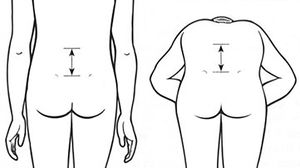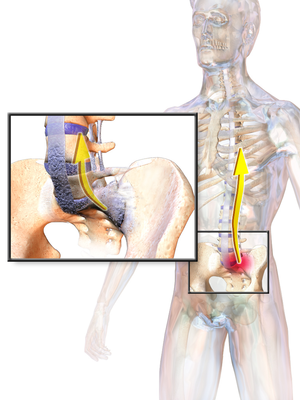Schober Test
Purpose[edit | edit source]
Schober’s test is classically used to determine if there is a decrease in lumbar spine range of motion (flexion), most commonly as a result of ankylosing spondylitis.[1].
The measurement of this test is useful for
- Screening the status of ankylosing spondylitis disease
- Determination of progression and therapeutic effects of ankylosing spondylitis and other pathologic conditions associated with low back pain[2].
Technique[edit | edit source]
Schöber Test
- Patient is standing, examiner marks the L5 spinous process by drawing a horizontal line across the patients back.
- A second line is marked 10 cm above the first line.
- Patient is then instructed to flex forward as if attempting to touch his/her toes, examiner remeasures distance between two lines with patient fully flexed.
- The difference between the measurements in erect and flexion positions indicates the outcome of the lumbar flexion [1].
Modified Schober Test (eliminates the errors in identification of lumbosacral junction and makes sure that the entire lumbar spine was included[1][3]
- Patient is standing, examiner marks both posterior superior iliac spine (PSIS) and then draws a horizontal line at the centre of both marks
- A second line is marked 5 cm below the first line.
- A third line is marked 10 cm above the first line.
- Patient is then instructed to flex forward as if attempting to touch his/her toes, examiner remeasures distance between the top and bottom line. [1].
Interpretation[edit | edit source]
For both versions of the test, an increase of less than 5cm is a positive test and may indicate ankylosing spondylitis (AS). (Image shows region of spine mainly involved in AS)
Positive Schober’s Test
Less than 5cm increase in length with forward flexion: Decreased lumbar spine range of motion, ankylosing spondylitis
Clinical Notes[edit | edit source]
This test is almost exclusively associated with Ankylosing Spondylitis but may also be positive due to a decrease in lumbar range of motion due to pain or congenital anomalies or segmental fusion[4].
Evidence[edit | edit source]
- Original Schöber Test
The validity against radiographs was according to Macrae. strong (r=0.90), according to Rahali-Khachlouf. moderate (r=0.68).
The interclass (r=0.90) and intraclass (r=0.96) reliability was found to be excellent[1]. - Modified Schöber Index
The validity against radiographs was according to Macrae. strong (r=0.97), according to Rahali-Khachlouf. moderate (r=0.59).
The interclass (r=0.92) and intraclass (r=0.96) reliability were found to be excellent[6]. - Modified-modified Schöber Test
The validity of the modified-modified Schober test is moderate (r=0.67) with an excellent interclass (r=0.91) and intraclass (r=95) reliability[1].
References[edit | edit source]
- ↑ 1.0 1.1 1.2 1.3 1.4 1.5 Rezvani A, Ergin O., Karacan I., Validity and reliability of the Metric Measurements in the Assessment of Lumbar Spine Motion in patients with Ankylosing Spondylitis., 2012, Lippincott Williams & Wilkins, SPINE vol 37, Number 19, pp E1189-E1196 (level of Evidence: 1B)
- ↑ Yen YR, Luo JF, Liu ML, Lu FJ, Wang SR. The anthropometric measurement of schober’s test in normal taiwanese population. BioMed research international. 2015;2015.
- ↑ Tousignant M, Poulin L, Marchand S, Viau A, Place C. The Modified–Modified Schober Test for range of motion assessment of lumbar flexion in patients with low back pain: A study of criterion validity, intra-and inter-rater reliability and minimum metrically detectable change. Disability and rehabilitation. 2005 May 20;27(10):553-9.
- ↑ Medisavy Schobers Test Available from:https://medisavvy.com/schobers-test/ (last accessed 30.5.2020)
- ↑ BJC Health Modified Schober's Test for Ankylosing Spondylitis. Available fromhttps://www.youtube.com/watch?v=B9RaFB5BwrQ
- ↑ M Tousignant, Poulin L, Marchand S, , the modified-modified schober test for range of motion assessment of lumbar flexion in patients with low back pain: a study of criterion validity, intra- and inter-rater reliability and minimum metrically detectable change, disability and rehabilitation, 2005, VOL.27, NO.10, Pages 553-559 (Level of evidence: 4)
- ↑ Schober Test for Lumbar Spine Flexion. Available from: https://www.youtube.com/watch?v=eYOUA9asDu8








